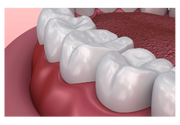Sealants
Seal Out Decay
The best dental gift is to be cavity-free. Approximately 90 percent of the decay in the teeth of children occur in tooth surfaces with pits and fissures, and almost two-thirds are found on the chewing surfaces alone. During growth, a child’s teeth frequently develop imperfections. These imperfections are called pits and fissures. Sealants are a safe, painless, and low-cost way to help protect your child’s back teeth from decay. Sealants have been used on children’s teeth for more than 30 years.
What is a Sealant?

A sealant is a thin, plastic, tooth-colored or clear coating that is painted to the chewing surfaces of a back tooth. This special plastic forms a hard shield that keeps food and bacteria from getting into the tiny grooves of a tooth.
Why Should Children Have Sealants?
Pits and fissures fill with bacteria and food when the child eats. The bristles of a toothbrush are too thick to reach into these imperfections and remove the food and bacteria that get trapped there. Bacteria immediately act on the food and form acids strong enough to weaken and destroy the enamel of the tooth. Destruction of the tooth continues, forming a cavity.
How Are Sealants Applied?
Applying sealants is quick and easy. There’s no numbing and no pain. The tooth is cleaned first. It is then conditioned and dried. The sealant material is then brushed onto the tooth’s grooves and allowed to set with a special light. It only takes a few minutes per tooth, only takes one visit, and the child can eat normally right away.
Which Teeth Should Be Sealed?
Usually the permanent molars and premolars are sealed. Fluoride helps protect the smooth surfaces on the front teeth and on the sides of the back teeth. But only sealants can protect the chewing surfaces. It is best to apply sealants soon after the permanent molars erupt. Many times baby molars may benefit from the protection of sealants. Talk to your pediatric dentist, as each child’s situation is unique.
How Long Do Sealants Last?
Sealants can last for 3 to 5 years. Due to chewing and the abrasive nature of some foods, such as crunchy candy, sticky foods, or ice cubes, sealants may be dislodged or damaged. Grinding can also affect the longevity of sealants. If they chip or come off, they can be easily replaced. Any problems can be detected and corrected at a child’s six month dental checkup.
